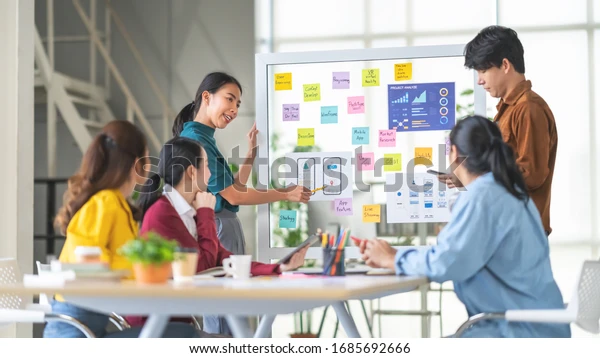
All organisations have work teams. These teams refer to a group of employees assigned to work on a task together. Work teams are needed because they help accomplish tasks, detect problems, and brainstorm solutions faster. Each member of the team provides different skills that can help the team become quicker and more efficient when working on tasks.
When working in teams, it is important to establish a good workplace relationship with your teammates. A good workplace relationship has constant communication, trust, and teamwork. As a leader, it is vital to know who you will be building your workplace relationships with.
While you may consider the managers’ typical relationship to be with those they manage, it can be much deeper than this. It can include other people from within your organisation and those who visit your workplace at various times.
The primary relationships you will be establishing in your workplace are:
- Self as manager and those who one manages
- Self as manager and one's supervisor
- Self as manager and other relevant stakeholders
Self as manager and those who one manages
The primary relationship any manager has is with those whom they manage. You may like to call those you manage as your subordinates or members of your team or workgroup. This relationship is the most important because one of the primary goals of a manager is to attempt to manage the relationships with those whom one manages to maximise their performance and attain organisational goals. Therefore, the ability to act within the given boundaries of such a relationship allows you to ensure that you are acting in the best interests of your staff By doing this, you should be able to show your staff that you are a professional manager. If you are able to give this impression to your staff, they will respect you and be willing to follow you, making the management process much easier.
Self as manager and one’s supervisor(s)
Even though you are a manager, it is likely that you have staff members that you are responsible for in your duties. This relationship should be one of mutual respect. Think about how you would expect a relationship between you and your subordinates to be; this is most likely the level of respect and authority that your supervisor expects of you. As you are both managers, there is an expectation of professionalism and if you are able to show how professionally you take your job and you build a professional working relationship with set boundaries, you can expect the same in return.
Self as manager and other relevant stakeholders
Stakeholders are individuals and groups, both inside and outside an organisation, which have some direct interest in that organisation and its behaviour, actions, products, or services. They can include owners, shareholders, suppliers, customers, special interest groups, statutory agencies, and other regulatory bodies outside an organisation. They can also include managers, employees, employee organisations, and other employee representatives within an organisation. Stakeholders are integral to the success of any organisation as they provide a wide range of information and services. By showing professionalism in your relationships with them, you will build stronger working relationships that will serve to improve your organisation overall.
Creating a good workplace relationship with your workmates is an important part of being a manager. A good workplace relationship can help you establish your team’s objectives. These objectives can help your team work towards the same goals and can also inspire them to work harder and perform their tasks better.
Establishing Team Objectives
Team objectives refer to the goals a team wants to achieve. These goals are used to monitor the workplace performance of the team and its members. Team objectives need to be established because:
They keep team members motivated
Setting team objectives is a great way to keep your team motivated. It reminds them of the tasks that need to be done and the goals you want to achieve. It also reminds them that what they are doing contributes to a bigger purpose.
They ensure that each member is on the same page
Another reason team objectives need to be established is because they promote transparency in your workplace. They help ensure that everyone is aware of the goals the team is working on and that the distribution of work is equal among members.
They encourage collaboration between individuals
Team objectives help members work together towards a common goal. They help foster teamwork instead of a competitive and individualistic mindset. They also help members realise that they can finish tasks faster if they work together.
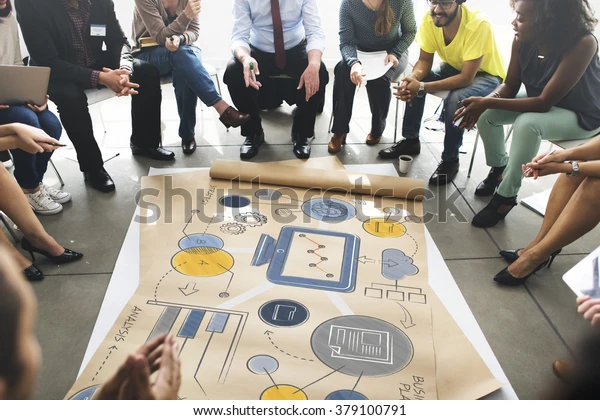
When establishing your team’s objectives, it is important to know the kind of objectives you should be creating. Some common team objectives you can expect to find in your workplace include:
 |
 |
 |
 |
| Closing or increasing sales | Increasing productivity rate between team members | Increasing production rate | Decreasing costs on software or projects |
All workplaces have their own team objectives. While the objectives provided above may be common to most workplaces, your workplace may have its own unique objectives as well.
Organisational Strategies
Team objectives are closely related to organisational strategies. By definition, organisational strategies are all the tasks you want to achieve so you can reach your organisation’s long-term goals. These strategies are developed in-line with your organisation’s mission. This means that your organisation’s mission is the guiding light for your organisational strategy.
You can think of an organisational strategy as the sum of all your team objectives. It is like a long-term plan of all everything your team wants to achieve. Organisational strategies are important because they help each team member stay on the same page and help direct them to the direction the organisation wants to take.
Some common organisational strategies include:
Growth strategies
Growth strategies are one of the most common organisational strategies. These strategies are often used to increase your organisation’s sales and revenue or the services your organisation offers. They can also be used to achieve personal growth within employees.
Research and development strategies
Research and development strategies are used to innovate an organisation’s services or products. They are also used to introduce new products or processes into your organisation and make improvements to what currently exists in your organisation.
Marketing strategies
This strategy focuses on gaining new customers and spreading your organisation’s brand to its target market. Here, organisations focus on the advantages they have over other companies that may help them succeed in their chosen field. You can find marketing strategies everywhere these days. Some common marketing strategies you can find include social media marketing, YouTube advertisements, and conversational marketing.
As mentioned earlier, organisational strategies are closely related to your team’s objectives. For example, if your team objectives are focused on promoting communication in your workplace, you can expect your organisation to have strategies like these to promote communication among members:
- Conducting surveys on the quality of communication in your workplace
- Measuring how effective existing communication methods are
- Directly addressing workplace gossip
You can expect to achieve your objective of promoting communication in your workplace once these strategies are implemented and properly executed.
Work tasks refer to the responsibilities employees have that are related to their job role. There are different work tasks for a variety of job roles. For example, managers oversee an organisation’s employees and ensure that the organisation’s goals are met. In the same way, doctors treat and diagnose patients while retail workers sell clothes and help customers. Because your work tasks can vary depending on the type of job you have, always make sure you know how to achieve your tasks.
Achieving your work tasks involves collecting and analysing information. Collecting and analysing information helps you achieve your work tasks because they help clarify each aspect of your work task. They also help you gain a full understanding of your work task and help increase your productivity in the workplace.
Information can come from many sources, like data that is appropriate to work roles and organisational policies that are shared and retrieved in writing or verbally, electronically, or manually. This information can include:
- Archived, filed, and historical background data
- Individual and team performance data
- Marketing and customer related data
- Planning and organisational documents including the outcomes of continuous improvement and quality assurance
- Policies and procedures
This information is useful for achieving your work tasks. For example, your organisation’s policies and procedures can help you determine what is expected of you when you are performing your work tasks. Because of this, it is important to gather information on your work practices and ensure that they come from credible sources.
Gathering Information
Gathering information about your work task is important because it helps you gain knowledge of your work tasks. It also helps you visualise your work tasks better and see how they could be applied in your workplace.
When you need to gather information about your work tasks, it helps to think of the process as a series of steps.
The steps in the information gathering are:
 |
 |
 |
| Establishing a goal | Determining information sources | Choosing a method to collect information |
Establishing a goal
The first stage of the process involves establishing a goal for your information gathering. This involves asking yourself why you are gathering this information. This goal is important because it helps you ensure that you stay on track. It also helps prevent you from gathering information that is not relevant to the task at hand.
You should ensure to clearly explain your goal to all the staff involved in the process. If they know why you want to know something, they are more likely to be forthcoming. Examples of goals may include:
- Prepare a cost report for the new widget manufacturing process
- Write a job description for Andy Smith
- Conduct a satisfaction survey of all staff in the Accounting Department
Once you determine why you are gathering your information, you can then determine where you will be getting this information from.
Determining information sources
Determining where your information comes from is an important part of gathering information. The information that you can gather can be of two major types, namely: primary and secondary information.
Refer to the table below to know the difference between the two:
|
Type |
Definition |
Sources |
Problem |
|
Primary |
Information you gather and record yourself. |
Questionnaires, surveys, interviews, observation, experiments, historical information, and raw data. |
Information must be gathered carefully to ensure it is accurate and bias free. |
|
Secondary |
Information gathered and recorded by others. |
Books, internet, reports, newspapers, magazines, pamphlets, and journals. |
Information may be inaccurate, out of date, or biased. |
These types of information can then be further divided into internal and external sources:
Internal information sources are resources that you utilise from within your organisation. These may be personal sources (such as your own knowledge), interpersonal sources (relying on the expertise of others), or documented sources from the information systems within your organisation. The principal advantages of this type of data are that the data is readily available, reasonably accessible on a continuous basis, and that it is particularly relevant to the organisation’s situation.
An example of an internal source is a company’s internal accounting records and control systems. These sources provide the most basic data on management inputs and the resulting outcomes. Data on the inputs to the management system can range from budgets and schedules to costing reports and materials planning information. Extensive data on outcomes can be obtained from billing records, shipment information, and other aspects of the accounting information system. The internal information from an organisation can be used for many reasons.
External sources, on the other hand, are wide-ranging and include any information that does not come from official organisational sources. This may come from information providers such as the government, published data sources, or primary research conducted for the organisation by market research houses.
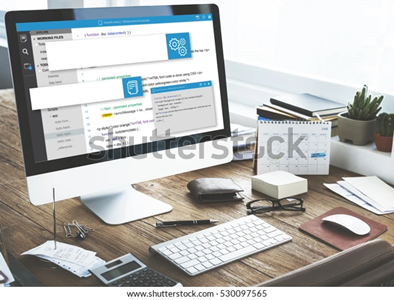
For further information on published data sources and primary research, refer to the guide below:
Published data sources
These sources are by far the most popular source of external information. Not only is the data readily available, but often it is sufficient to answer a decision question. For example, a manager may be asked to determine whether the market for a given product exists. By consulting statistics available from various sources, they may be able to answer this question. The major published sources are the various government publications, periodicals and trade journals, industry associations, and other companies. Of all these sources, one of the most effective decision-making tools comes from census data – this is particularly true for marketing decisions.
Primary research
Primary research involves employing an organisation to conduct a research project on your behalf to gather the information you need. While this can pinpoint the exact piece of data you may need, it is very costly. Often, marketing decisions utilise this type of service; however, there may also be a need for this type of research and data gathering for other reasons as well. The most important consideration is the cost and time. This type of data collection is expensive and time-consuming; however, given that it can provide you with tailor-made information, you may find it useful for specific tasks.
Choosing a method to collect information
Once you have determined the goals and sources of your information, you need to think about how you plan to go about collecting the information. There are various ways to gather information – some of the most useful are presented below:
Asking questions
One of the best ways of gaining information is to simply ask questions. While this may seem simple, it is important to remember that there is in fact a range of types of questions that you can ask. These include:
- Closed questions that require a ‘yes’ or ‘no’ answer
- Open questions that encourage comments
- Probing questions that attempt to get to the heart of the problem
- Hypothetical questions which are ‘what-if’ questions
Interviews
This is a skill in which most managers need practice and training. When gaining information through an interview, it is important that you prepare well in advance. Ensure to consider who you will be interviewing and how they are likely to feel about the questions you ask. By using a range of different question types, you put yourself in the best position to gain the right information.
Surveys
Surveys are a sure way to gather information from anyone in and out of your organisation. They are flexible, accessible, and relatively easy to prepare. If you choose to conduct a survey, be sure to dedicate enough time to prepare it. Before you roll out the official survey, try to create a draft survey first and test it. This will help you determine if the survey can collect the information that you are looking for.
Surveys can be complicated to set up because they allow for bias if not correctly worded. However, they are good tools for quickly gaining information and allowing for easy analysis of the information that you gain. When conducting a survey, you must make sure that the questions you ask are:
- Relevant to the issues
- Objective
- Easy to understand
- Open and leading questions
Meetings
This involves bringing together all those that will be able to provide you with the information that you need in order to meet your objective. The group can provide you with what you need and will help you discuss ideas by identifying ideas and looking at each one critically.
Brainstorming
This is an ideal way to get ideas from your work team. It is most often used during team meetings in order to allow everyone to have their say and to generate a wide range of ideas that will be used for further clarification of ideas. It is important that you allow ideas to flow without criticism of any kind (until the evaluation stage arrives). By doing this, people will be encouraged to contribute without having their ideas ridiculed.
The information you gathered should then be analysed for you to determine whether it can help you with your work tasks. Remember that analysing the information you gathered can help you feel less overwhelmed about the information that is available to you.

Analysing Information
Analysing the information you gathered helps you understand what your information means. It helps you see where your knowledge can be applied and whether the information you gathered is important.
Refer to the following guide to help you learn how to analyse information:
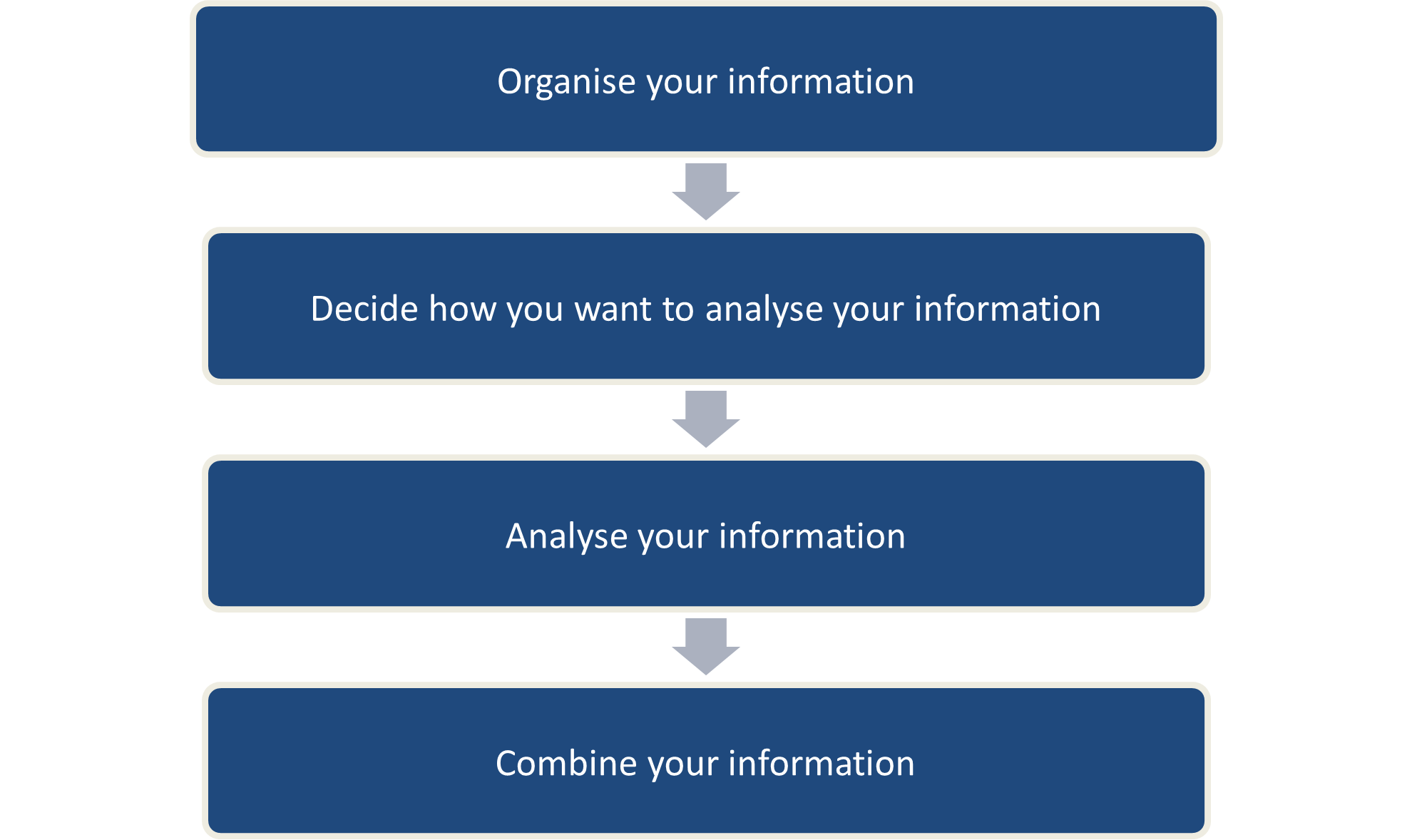
Organise your information
This step involves gathering the information you collected and sorting it out into important and non-important information. Important information can refer to the information you can use to successfully achieve your work tasks, while non-important information can be information that you can choose to leave out. You can also organise your information according to which pieces belong together.
Decide how you want to analyse your information
Here, you must ensure to relate the information you gathered to each other by comparing, averaging, or examining your information until you can see a relationship between each part. How you will analyse your information will depend on the type of information you have and how you want to use it. For example, you can choose to organise this information by grouping them based on their similarities or differences.
Analyse your information
This step is the heart of the entire process. Here, you must review everything you learned about the information you gathered. You can choose to identify information that may seem biased or illogical. You can also look out for gaps, similarities, and insights in the information you gathered. For example, you can choose to look for similarities and differences between the different work tasks in your organisation. You can also find a relationship between your work tasks, which can help you finish tasks faster.
Combine your information
After you have analysed your information, you can then begin putting pieces together until they can tell a cohesive story. This step is important because it helps you note insights and realisations you may have about your work tasks. It will also help you think of different ways to use the information you gathered that would help you be successful in your workplace.
The information you gathered and analysed can help you achieve a great work task. This information will also help you develop solutions to difficulties you may face in your workplace.

Communication is the process of trying to ensure that others understand exactly what your point of view is. It involves a message being sent by you and that message being received by another party. Up to this stage, much focus has been given on getting information from others in your organisation. However, it is also likely that you will need to provide information and ideas to your team.
Information differs from ideas in many ways. Information focuses more on learned details and provided facts. Ideas, on the other hand, focus more on suggestions and thoughts about possible tasks or actions. Both, however, are important in your workplace.
You may be asked to communicate a wide range of information in your workplace. For example, you may be expected to communicate your concerns about your work tasks, or you may be asked to share information on what you do in your workplace. When these types of information are expected from you, it is always important to be sure that you are familiar with your work tasks.
Being familiar with your work tasks involves asking questions about tasks that may seem confusing to you. For example, you may want to share your experiences with a higher-up and ask if you are doing the right thing. You may also want to discuss points that may need clarifications, or you may want to have someone check on your work to see if it is satisfactory. All these things are considered as a form of consultation.
Consultation
Of all the types of communication present in your workplace, consultation is perhaps the most important. Consultation is vital because it helps you fully understand your work tasks. It also helps you create solutions that can help you do your tasks better. You must be familiar with the different consultation processes so you can be better equipped when you wish to schedule a consultation.
Some common consultation processes include:
- Feedback to the work team and relevant personnel in relation to outcomes of the consultation process
- Opportunities for all employees to contribute to ideas and information about organisational issues
Running a genuinely consultative process involves a lot of work. You have to know when you can consult, how you are going to consult, who you are consulting, and how long the discussion is going to take place. You also need to be knowledgeable on your topic so you can ask the right questions and be able to determine the right answers that may satisfy these questions.
Refer to the discussion below for more guidance on the consultation process:
Preparing for consultation
Preparing for consultation will always involve researching on your topic. This is important because it helps you ensure that you are prepared and that you know what you are going to ask. Because of this, make sure to research on your topic before you before begin planning your consultation. Doing so will provide valuable clues as to team opinions or might give you an insight into the issue itself and how it has played out in the past.
Before you embark on a consultative process, make sure you know the following:
Who to consult
After you have researched on your topic and have determined the various elements of your consultation, you can then begin looking into who you want to consult. You can achieve your desired changes and your organisation’s goals if you consult and involve relevant stakeholders in your process. Stakeholders are an important part of the decision-making process. They refer to any group, institution, or individual who has a role or interest in your organisation’s work practices and in developing solutions to address workplace limitations.
There are two types of stakeholders, namely:
Internal stakeholders
This type of stakeholder refers to people within your workplace. Examples of this include:
Employees
Employees are the most essential stakeholders in an organisation. They provide information on the organisation and the behalf of clients. They are also the ones who have the most knowledge of work practices and workplace limitations because they experience it first-hand.
Supervisors
Supervisors oversee tasks or progress of employees in your organisation. They make certain that your organisation’s goals are met. They also ensure that work flows smoothly on a daily basis, and they determine whether work practices should be created or revised.
Internal stakeholders are directly involved in every aspect of the organisation. They are the people who are most affected by the decisions your organisations make. For example, if your organisation experiences a mass layoff, the employees are most affected by this decision. Similarly, if your organisation decides to change something in your work process, this will affect everyone in your team.
External stakeholders
External stakeholders, on the other hand, refer to people outside your organisation who care about your organisation’s performance. These people may include:
Clients
Clients make decisions that improve your organisation’s performance. They help provide information on the quality of your organisation’s products and services by providing feedback and requesting changes.
Suppliers
Suppliers provide your organisation with the goods needed to implement your organisation’s goals and objectives. Their products are directly affected by how your organisation chooses to use them. In the same way, their products help determine the quality of your organisation’s output.
External stakeholders are the ones who are affected by the consequences of each decision made by your organisation. For example, clients would be affected by the quality of the products your organisation produces.
Stakeholders are important because they can help provide information on your workplace’s problems and the limitations that come with your work tasks. They provide first-hand knowledge on how effective work practices are. When solutions to problems are implemented, they are also the ones who experience the change first-hand. Because of this, it is important to consult your organisation’s stakeholders when developing proposals and making decisions.
When to consult
Consultation is needed to avoid mistakes and confusion about your tasks and the decisions you make in your workplace. It is always better to err on the side of consultation, regardless of how big your decision or task is.
Consultation is particularly important when:
- Major decisions need to be embraced by a particular team
- Consultation is required by law.
- The aim is to educate or change behaviour.
- You need support to carry your decision or task through.
- You are seeking different opinions and collective input to reach an effective solution.
- You want to motivate people and inspire action.
- You want other teams or organisations to back-up your position
- You should consult whenever you are making a decision that will likely impact other people.
How to consult
Before you embark on a consultative process, you need to have sufficient understanding of how exactly you should go about it. More specifically, here are some things that you would need:
An idea of the scale of the project
You need to have an idea of the scale of your project because this will help you determine the resources needed and the amount of time you need to set aside to complete tasks. Always ensure to have an idea of these factors so you can be more prepared for your consultation process.
Clearly stated aims and objectives for the consultation
Your aims and objectives should state what you need to know, the questions you want to ask, and the people you want to consult. It is important to determine these requirements in advance to make sure that your consultation process runs smoothly. This will also guarantee that you come to the consultation prepared.
A genuine desire to learn from your consultation
Having a genuine desire to learn from your consultation will help you address any concerns you have about your tasks and the decisions you have to make. Ensure to take into account any constructive suggestions and improve any weaknesses in your argument, plan, or position.
You can also follow the diagram below for a step-by-step guide on the consultation process. Remember that these steps are organisation-dependent and can vary depending on the type of stakeholders you are consulting.
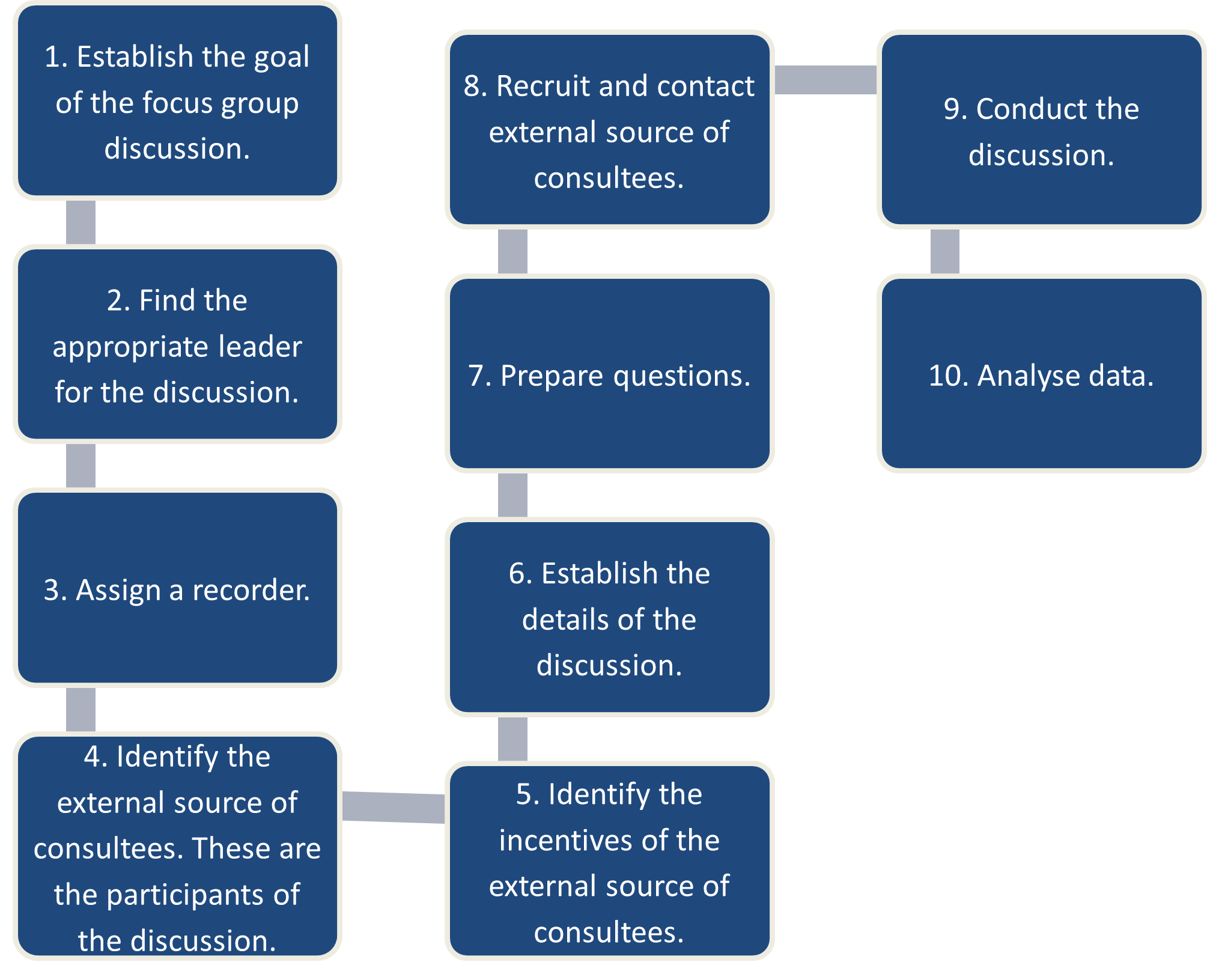
These steps can be useful for group consultations. You can schedule group consultations to increase your team’s understanding of a situation. For example, you can schedule a group consultation to discuss a new product that your organisation’s aiming to produce. Scheduling a group consultation will help ensure that everyone is on the same page, and it will also help team members contribute their ideas and insights to your discussion.
When conducting a group consultation, it is helpful to have a consultant that observes the group’s interactions during the meeting. These observations could then be relayed to the group to help them improve how they interact and behave around each other, so they can identify factors that can help them succeed or hinder their success.
How long to consult
Assessments, consultations, and inquiries are all essential, but at some point, of course, there will need to be outcomes. If consultation leads to a prolonged discussion without resolution or consensus, then this means that the process has broken down. The whole process is a complicated procedure for taking major decisions that tries to strike a balance between team involvement and decisive action. It is impossible to consult everyone on every decision.
Some good practices you can follow when communicating with diverse stakeholders include:
- Using a method of appointment to the decision-making level that people accept as legitimate
- Developing decision procedures (consensus/voting/facilitation) to ensure that discussion cannot drag on forever
- Developing clear guidelines around your timetable and make sure that your consultations work within these.
Always be considerate whenever you are talking to your stakeholders. You might notice times where you may have said something they might consider as rude or disrespectful. Moreover, you might also not notice if your questions are culturally inappropriate or create an awkward atmosphere during consultations. Because of this, it is important to always be respectful, considerate, and mindful of what you say when communicating with stakeholders.
Considerations for communicating information
As a manager, you should use a range of communication methods in your workplace. For example, you can use email, written communication methods, or oral communication. When choosing the communication technique you want to use, always consider who your audience is.
Many writers do not make adjustments when they write to different audiences, usually because they do not take the time to think about who will be reading what they write. To be sure that you communicate clearly in writing, you need to adjust your message - how you say and what information you include by recognising that different readers can best understand different messages.
Consider these techniques to convey information properly:
Use inclusive language
Do not use sexist or racist language (or language that may be interpreted as being that way) as it can often cause the individual to interpret your message negatively.
Avoid jargon
Using complicated language can make a message extremely difficult to understand for those who may have trouble communicating. Ensure that you present your message as simply as you can.
Get feedback
Feedback is crucial. Ask questions such as ‘Do you understand?’ as this can allow you to ensure that the receiver has correctly received your message and thus guaranteeing that your communication has been successful.

It is important to consider these techniques when communicating information in your workplace. But while these techniques are important, you must also consider the cultural aspect of your workplace.
Modern workplaces are diverse. They include men and women, people of all ages, races, levels of experience, and levels of education. Each of these factors has a significant influence on how the receiver of a message perceives your message. Often, you can find that an understanding cannot be reached immediately simply because your message was not received in the manner that you thought it would be. It may have been interpreted differently based on the age of the individual or because they do not understand English well.
Culture refers to the values, norms, and traditions that affect the way a member of a group typically perceives, thinks, interacts, behaves, and makes judgments. It also affects perceptions of time and holiday dates, which can impact day-to-day scheduling and deadlines.
Cultural competence is the ability to interact effectively with people from different cultures. This ability depends on the awareness of one’s own cultural worldview, knowledge of other cultural practices and worldviews, tolerant attitudes towards cultural differences, and cross-cultural skills.
The more different cultures work together, the more cultural competency training is needed. Cultural problems can range from miscommunication to actual conflict, all endangering effective worker productivity and performance. Because of this, it is always important to consider your audience when you are communicating information.
A culturally diverse audience consists of people that have varying factors such as national, ethnic, racial, and religious backgrounds.
When communicating information to a culturally diverse audience, always consider that:
- Language that can be offensive to some of the audience’s culture
- Interpretation of communication from people from another culture
Keeping these considerations in mind can help you ensure that you are being considerate of the person you are talking to. It also helps you understand the perspective of other people.
A socially diverse audience, on the other hand, consists of people that have varying factors such as socioeconomic status, geographical origin, sexual orientation, age, and gender. When communicating information to a socially diverse audience, ensure to consider the following:
- Complexity of terminologies that might confuse some of the audience
- Imposition of personal liberal statements that some of the audience might not be open to
Being considerate of your audience will help prevent conflicts and misunderstandings in your workplace. It will also ensure that no one gets offended by the things you say and promote a respectful and tolerant work environment.
Managing cultural and social diversity
Employers and employees have shared obligations for creating respectful and courteous workplaces. Employers want a productive workforce that manages its performance and achieves results. Employees, on the other hand, want to work in a place where:
- They know what is expected of them
- Their workplace is safe, and they are treated fairly
- Their skills and contribution are recognised and valued
- They can work harmoniously with others
Developing cultural competence results in an ability to understand, communicate with, and effectively interact with people across cultures and work with varying cultural beliefs and schedules.
While there are many cultural variations, here are some essential to the workplace:
Communication
Providing accurate information is critical to effective work and team performance. This is particularly important when a project is troubled and needs immediate corrective actions. However, people from different cultures react differently to various situations. For example, people relate differently to bad news. People from some Asian cultures are reluctant to give supervisors bad news, while those from other cultures may exaggerate it.
Team building
Some cultures are individualistic, and people want to do tasks alone, while other cultures value cooperation within or among other teams. Team-building issues can become more problematic as teams are comprised of people from a mix of these cultural types. Effective cross-cultural team building is essential to benefit from the potential advantages of cultural diversity in the workplace.

Time
Cultures differ in how they view time. For example, they differ in the balance between work and family life and the workplace mix between work and social behaviour. Other differences include the perception of overtime or even the exact meaning of a deadline. Different perceptions of time can cause a great misunderstanding and mishap in the workplace, especially with scheduling and deadlines. Perceptions of time underscore the importance of cultural diversity in the workplace and how it can impact everyday work.
Calendars
The business world generally runs on the western secular year, beginning with January 1 and ending with December 31. However, many cultures use other calendars to determine holidays such as New Year’s or specific holy days. These variations affect the workplace as people require time off to observe their holidays. A cultural calendar is a helpful tool to ensure meetings are successful and deadlines are met.
Intercultural communication
Intercultural communication principles guide the process of exchanging meaningful and unambiguous information across cultural boundaries. It preserves mutual respect and minimises antagonism between people in the workplace.
Because diversity in the workplace is increasing, it will require employees to have an understanding and ability to apply effective cross-cultural communication. It is important for people to realise that a basic understanding of cultural diversity is the key to effective cross-cultural communications.
Refer to the discussion below for a guide on how intercultural communication can be achieved in your workplace:
Consider any special needs the individuals on your team may have
Each member of your team can have different cultural needs. For instance, they may observe different holidays or even have different hours of operation. Be mindful of time zone differences and work to keep everyone involved aware and respectful of such differences.
Patience, courtesy, and a bit of curiosity go a long way. If you are unsure of any differences that may exist, simply ask team members. This may best be done in a one-on-one setting so that no one feels ‘put on the spot’, self-conscious, or embarrassed about discussing their own needs or differences.
Cultivate and demand understanding and tolerance
Cultivating and demanding understanding and tolerance in your workplace involves educating your co-workers on the cultural needs of others. For example, you can explain to team members that the part of the team that works out of the Australia office will be working in a different time zone, so electronic communications and/or return phone calls will experience a delay. You can also educate your team on the different holidays observed in different places around the world.
Most people will appreciate the information and will work hard to understand the different needs of others. Most will also understand the different means used to reach common goals. For instances where this is not the case, lead by example and make it clear that you expect to be followed down a path of open-mindedness, acceptance, and tolerance.
Learn the basics about culture and the language of communication in different countries
Learning the basics about culture and the language of communication in different countries is important. This is necessary even for the basic level of understanding required to engage in appropriate greetings and physical contact. For instance, kissing a business associate is not considered an appropriate business practice in Australia, but in Paris, one peck on each cheek is an acceptable greeting. And the firm handshake that is widely accepted in Australia is not recognised in all other cultures.

No man is an island, especially in a workplace setting. Accomplishing tasks alone can be considerably difficult, especially when you have no one to help you. Collaborating with others will help you fix this. Collaborating with others will enable everyone to contribute to your organisation’s continuous improvement. The only problem with this is that not everyone has the chance or is willing to voice their ideas out in the workplace.
The trick is to get employees to speak up is to allow them to contribute. If you want to get employees to think out-of-the-box, you need to motivate them with rewards and take their suggestions seriously. Doing so will encourage employees to come up with more creative ways of improving the workplace. Otherwise, everyone will think it is a waste of time to squeeze out creative juices for suggestions that will not be implemented anyway.
Collaborating with your team in developing strategies
Completing work tasks with your employees will involve developing strategies that can help the team to the job faster. A work task strategy will help guide you to become more efficient in accomplishing tasks. To develop these strategies, collaborate with your team and follow the steps below:
 |
 |
 |
 |
| Identify facts | Brainstorm strategic options | Evaluate your options | Choose the best option |
Identify facts
This step involves using the information you gathered from the previous subchapters to help you in identifying facts like:
- What your work task is about
- What needs to be improved so the team can accomplish tasks faster
- What can be done to remind employees of the organisation’s goals and objectives
It is important to gather information on these facts because they help your team stay in-line with the work tasks that need to be achieved. You can collaborate with your team to gather facts by:
- Asking members about their individual tasks
- Getting the opinions of other team members
- Organise information with your team
Identifying facts will also remind the team that their input plays a role in developing strategies that can help them execute their tasks.
The facts you gather in this step can then be used as a basis for the strategic options you develop with your team.
Brainstorm strategic options
This step is the heart of your process. Here, you and your team will be creating strategies that can ensure that your organisation’s goals and objectives are accomplished.
To brainstorm strategic options, always ensure to:
Explore different possibilities
It is important to allow the team to explore different possibilities because it will help them realise that there is more than one way to accomplish a task or solve a problem. Doing so will also help prevent creative burnout and will discourage the team from sticking to one route when tackling the situation at hand.
Some of the most creative ideas are born out of brainstorming sessions where a group of people discuss and debate about possible solutions to a problem. Having such a private channel for employees to contribute ideas may thus hinder the creative process. Moreover, those who provide effective ideas will not get identified and get the recognition they need. It will be wise to balance both private and public mediums for employees to propose their suggestions.
Encourage collaboration between team members
Collaboration is the best way to get your team to accomplish a task. By collaborating with different team members, you can guarantee that the team is working towards a common goal by contributing their ideas and thoughts into the process. You can also ensure that your team members are productive, engaged and that they can contribute to achieving the work task.
Some collaboration tools you can use to develop strategies include:
- Group calendars
- Collaboration software
- Chat system
 |
 |
 |
| Group calendar | Collaboration software | Chat system |
Group calendars
Group calendars help you keep track of the tasks of each team member. These calendars are helpful in developing strategies since they help the team monitor their deliverables and schedules. The more you can monitor each member’s tasks, the more you can see how effective the current strategy your team’s following is.
Collaboration software
Using software to collaborate with your team is quite common nowadays. For example, many organisations use apps like Asana to assign tasks to team members and monitor deadlines.
Chat systems
Chat systems are a great way to get your team to communicate in a +n informal setting. Your team can use chat systems to message each other about possible ideas or questions that may arise while they are performing their tasks. They can also use chat systems to communicate ideas about possible strategies that may help them accomplish tasks faster.
A more detailed discussion on collaboration will be provided in the next subsection.
Welcome all ideas
Welcoming all ideas will encourage the team to speak out more and share whatever they have in mind. It will help motivate the team to be more confident when speaking in a group. It will also help team members feel like their opinions matter and that their suggestions will be considered.
Evaluate your options
When evaluating your options, you can ask yourself the following questions for guidance:
Is it feasible?
Checking your strategy’s feasibility is the first thing to consider when developing a solution. It helps you determine whether you can or cannot implement your devised alternatives. It is easy to overlook this step when you are busy formulating options, but always remember to check if your strategy can be done so you will not encounter problems later on.
Would it actually help you accomplish tasks better?
Some strategies may be great in theory but not so effective in actuality. Determine whether your strategy helps you effectively accomplish tasks. Your strategy should:
- Be clear and concise
- Be structured
- Address your goals
- Break barriers
- Be effective
Who would be affected by these solutions?
Creating an effective solution involves considering the perspectives of the members of your organisation. Always consider who will be affected by your solution so it can benefit as many people as possible.
Choose the best option
After you have made a list of all possible strategies, narrow your choices down to the best possibilities. You can continue doing so until you have found the best solution that will best address your workplace limitations.

